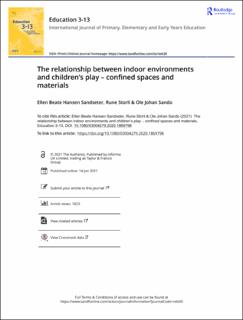| dc.contributor.author | Sandseter, Ellen Beate Hansen | |
| dc.contributor.author | Storli, Rune | |
| dc.contributor.author | Sando, Ole Johan | |
| dc.coverage.spatial | Norway, Trondheim. | en_US |
| dc.date.accessioned | 2022-03-07T09:16:27Z | |
| dc.date.available | 2022-03-07T09:16:27Z | |
| dc.date.created | 2021-01-15T14:46:17Z | |
| dc.date.issued | 2021 | |
| dc.identifier.citation | Education 3-13: International Journal of Primary, Elementary and Early Years Education. 2021, 1-13. | en_US |
| dc.identifier.issn | 0300-4279 | |
| dc.identifier.uri | https://hdl.handle.net/11250/2983326 | |
| dc.description.abstract | The provision of environments that support and afford play is fundamental for young children’s experiences, learning and development. Play environments of Early Childhood Education and Care (ECEC) institutions are therefore of great importance for the opportunities provided children to create and engage in a wide range of play. This study examines the association between Norwegian ECEC institutions’ indoor environment (spaces and materials) and children’s engagement in different types of play. Children (3– 6 years, N = 86) were observed in two-minute sequences during periods of the day when they were free to choose what to do. The data consists of 943 randomly recorded two-minute videos, which were coded second-bysecond to register the type of play occurring, the space in which it occurred and the materials children used. The results show that the indoor environment in the participating ECEC institutions afforded predictable play types in what could be called confined spaces designed and furnished for certain kinds of play activities. The authors discuss how this helps practitioners maintain predictability and control of children’s play, while on the other hand, it restricts children’s play and freedom to bring their own initiatives, ideas and creativity into the play in unpredictable ways. | en_US |
| dc.language.iso | eng | en_US |
| dc.publisher | Taylor& Francis | en_US |
| dc.rights | Attribution-NonCommercial-NoDerivatives 4.0 Internasjonal | * |
| dc.rights.uri | http://creativecommons.org/licenses/by-nc-nd/4.0/deed.no | * |
| dc.subject | Early childhood | en_US |
| dc.subject | play | en_US |
| dc.subject | indoor environments | en_US |
| dc.subject | affordances | en_US |
| dc.subject | Norway | en_US |
| dc.title | The relationship between indoor environments and children’s play – confined spaces and materials | en_US |
| dc.type | Peer reviewed | en_US |
| dc.type | Journal article | en_US |
| dc.description.version | publishedVersion | en_US |
| dc.rights.holder | ©2021 E.B.H. Sandseter; R. Storli; O.J.Sando | en_US |
| dc.subject.nsi | VDP::Samfunnsvitenskap: 200::Pedagogiske fag: 280 | en_US |
| dc.source.pagenumber | 1-13 | en_US |
| dc.source.journal | Education 3-13: International Journal of Primary, Elementary and Early Years Education | en_US |
| dc.identifier.doi | 10.1080/03004279.2020.1869798 | |
| dc.identifier.cristin | 1872208 | |
| dc.relation.project | Norges forskningsråd: 270727 | en_US |
| cristin.ispublished | true | |
| cristin.fulltext | original | |
| cristin.qualitycode | 1 | |

